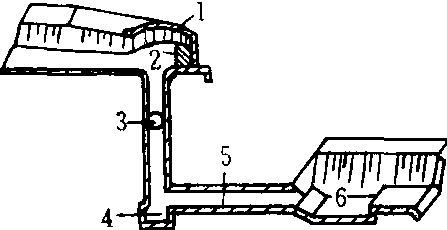跌井hydraulic drop well
当渠道或泄水道等通过高差较大的直立陡坎或陡峻地段时,所采用的水面自由跌落的竖井。下跌水流通过竖井再转向水平洞,经消能后流入下游渠道或泄水道,以免冲刷。由进出口连接段、竖井、水平洞、消力池等组成。竖井中水流为满流。当泄流量较小时,洞内水流连续性会遭破坏,水流很不稳定,易产生负压,发生振动和空蚀,需设置通气孔,保证有足够的通气量以减少负压。可用砌石、混凝土或钢筋混凝土修建。适用于地形陡峻且可以开井的岩基或坚固、稳定的土基。中国西北一些地区灌溉工程中曾采用,一般应用较少。

跌井
1.进口圆围墙 2. 防涡墙 3. 竖井 4. 消力井 5. 横管 6. 消力池